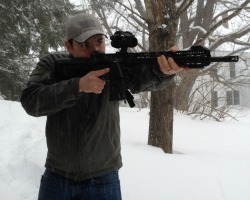 In the big business of survival and firearms, our time is a great time. Product demand is up; political pressure and societal issues are making people more aware of their surroundings and possible predicaments. Never before has the survival and firearms industries been so driven to meet increased demands and increased call for sturdy, no-nonsense gear that will keep one safe when the chips are down and when it comes to firearms selection, it’s a buyer’s market. Pick your poison based on your personal interpretation of what you need, and go from there.
In the big business of survival and firearms, our time is a great time. Product demand is up; political pressure and societal issues are making people more aware of their surroundings and possible predicaments. Never before has the survival and firearms industries been so driven to meet increased demands and increased call for sturdy, no-nonsense gear that will keep one safe when the chips are down and when it comes to firearms selection, it’s a buyer’s market. Pick your poison based on your personal interpretation of what you need, and go from there.
By Drew, a contributing author of Survival Cache & SHTFBlog
Searching For The Leatherman Rifle?
There are many options to choose from;however, from what I have seen, it seems to be rather hard to find a “do-it-all” rifle. Want high capacity and light weight? No problem, here’s your perfect AR-15 or AK or 9mm carbine. Want something to engage targets or shoot a mule deer at 400 yards? Oops, that AR-15 doesn’t work so well anymore. How about this Remington 700 in .300 Winchester Magnum? Oh, you want to retain the detachable magazine and semi-auto platform yet still hit large targets with authority at 400 yards? Here you go! This M1A should be perfect! Oh! 12 pounds of rifle and optics is too much? Back to square one.
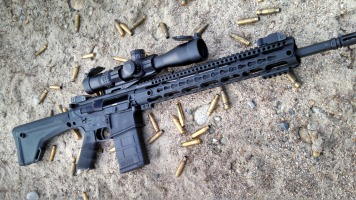
Of course, you can buy multiple rifles to fulfill all these different missions…there’s no better excuse to buy more guns! But what if I told you that there IS a rifle out there (just came out, as a matter of fact) that is as close to a have-your-cake-and-eat-it-too SHTF rifle as I’ve seen? True story. It fulfills all the requirements I listed above:
Specs
-Relatively light weight: 8.45 lbs (but in your hands, it definitely feels lighter)
-Semi auto platform, easily obtained detachable magazines (up to 25 round capacity)
-Everyday readily obtainable/useful caliber: .308 Winchester/7.62×51 NATO
-Able to dispatch large game and errant engine blocks at respectable ranges, out around 400+ yards with good optics, load selection, and (most importantly!) practice.
-A modern design, assembled with top-notch components.
Related:The AK-47 vs AR-15: Which Rifle is Better?
The Rifle
This rifle is the Windham Weaponry R18FSFSM-308. If that jumble of numbers and letters doesn’t mean much to you, let me give you the specifics.
-AR-10 platform, direct gas impingement, semi-automatic
-18” 4150 Chrome moly vanadium 11595E steel fluted barrel, medium weight, 1:10 twist, with an A2 flash suppressor
-Flattop upper receiver, no sights, optics ready
-Midwest Industries 15” aluminum free-float keymod rail fore end
-Magpul Industries MOE fixed rear stock
–Hogue Overmolded pistol grip
-Black hard anodized finish
-Comes with 20 round Magpul PMAG
-8.45 lbs, 38.785” long
-MSRP of $1,732.75. Going online for approximately $1,400-1,500.
Compare that with the Springfield Armory M1A SOCOM16:
-M1A platform, gas operated, semi automatic
-16.25” barrel, 1:11” twist
-fixed composite stock, no rails or attachment points except forward “scout” scope mount rail on top of the rifle, fixed sling loops
-pre-WW2 technology (a modification of the 1936-era M1 Garand)
-1/2 MOA click-adjustable aperture sights included
-comes with 10 round steel magazine
-8.8lbs, 37.25” long
-MSRP of $1,905.00; going online for approximately $1,500-1,800.
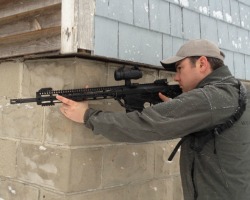 The SOCOM II, Which is basically the same rifle with a removable rail system up front, is out there too – but it’s heavier, and good luck finding one under the $2k mark. The wood-stocked M1A “Scout Squad” could be a more traditional, contender, but it has no modular rail system, and it’s over 40” long.
The SOCOM II, Which is basically the same rifle with a removable rail system up front, is out there too – but it’s heavier, and good luck finding one under the $2k mark. The wood-stocked M1A “Scout Squad” could be a more traditional, contender, but it has no modular rail system, and it’s over 40” long.
You COULD compare it to the FN SCAR 17 platform, or the FN FAL, or HK 91, but in my opinion, the price, lack of easily obtained magazines, and/or general unavailability of these guns puts them out of my consideration. Plus, they aren’t exactly made here in the good ol’ U.S.A: something that is important to many of us. (The semi-auto SCAR is made in Belgium; the select-fire ones are made in South Carolina)
As I write this, I have a SOCOM 16 available for comparison’s sake, and holding the two side by side, I will tell you that the phenomenally better AR ergonomics and better weight distribution of the Windham Weaponry R18FSFSM-308 take the cake here. I haven’t yet had the opportunity to shoot these rifles side-by side at the range. However, having had trigger time behind both of these platforms, I’d personally grab the AR-10 platform any day of the week over the SOCOM16 to head out the door with. But that’s for another article.
The Company
 Before I go too much further, let me get Windham Weaponry on your radar. Windham Weaponry may very well be the best AR manufacturer you haven’t heard of. W-W’s story starts in 1976 when a man named Richard Dyke purchased a bankrupt firearms manufacturing company from Bangor, ME. You may have heard of the company: Bushmaster Firearms. Richard took the Bushmaster tooling to Windham, ME, and breathed new life into the company over the course of several years. With hard work and a quality product, Bushmaster ended up enjoying a lion’s share of the AR-15 market. Dyke sold Bushmaster to Cerberus Capital Management, who took the company out of Maine and relocated it to New York. Dyke waited until the no-competition clause expired, and founded a new company, Windham Weaponry. He re-hired many of the employees that helped make Bushmaster great, added some new people, and instilled in them the philosophy of building the finest AR rifles in the industry. The company hit the ground running and hasn’t looked back since. They are now producing brilliant AR-based rifles of very high quality for a comparatively low price; if you’re looking to purchase a complete rifle or build a custom AR from components, you really need to look them up.
Before I go too much further, let me get Windham Weaponry on your radar. Windham Weaponry may very well be the best AR manufacturer you haven’t heard of. W-W’s story starts in 1976 when a man named Richard Dyke purchased a bankrupt firearms manufacturing company from Bangor, ME. You may have heard of the company: Bushmaster Firearms. Richard took the Bushmaster tooling to Windham, ME, and breathed new life into the company over the course of several years. With hard work and a quality product, Bushmaster ended up enjoying a lion’s share of the AR-15 market. Dyke sold Bushmaster to Cerberus Capital Management, who took the company out of Maine and relocated it to New York. Dyke waited until the no-competition clause expired, and founded a new company, Windham Weaponry. He re-hired many of the employees that helped make Bushmaster great, added some new people, and instilled in them the philosophy of building the finest AR rifles in the industry. The company hit the ground running and hasn’t looked back since. They are now producing brilliant AR-based rifles of very high quality for a comparatively low price; if you’re looking to purchase a complete rifle or build a custom AR from components, you really need to look them up.
I’ve personally toured their plant and I took my AR armorer’s course through Windham Weaponry. They are nothing short of outstanding in their field. Every Single Part, gets completely inspected at least three times: once upon receipt, once before assembly, and once after assembly. Components like barrels and receivers that head out for finishing or machining processes are inspected before and after – and the QC guys are ruthless. For instance, they showed me the barrel inspection process: a bore-camera was run down each and every bore, concentricity was checked, finish was inspected. They had a bin off to the side with barrels that didn’t make the grade. And these guys didn’t care if the barrel had gone through an expensive custom machining process: one flaw, it was rejected. No if, ands, or buts. Every part was held up to these high standards, and the end result shows their commitment to quality. Windham Weaponry guns are comparative works of art in the sea of industry-driven mass-produced products.
So when I contacted them about reviewing a new product, they told me they were just about to introduce their new Magpul fixed-stock 18” .308, and I’d be welcome to try it out. I jumped at the chance, and quickly enough I’d filled out the 4473 and the rifle was on its way home with me. I opened the case, and saw that they were nice enough to include their new proprietary line of rail-mounted sights (see my review of them here), and a couple 5-round steel magazines, since I’d told them I planned on hunting deer with the rifle this past whitetail season. Just as a note – these rifles ship without sights and with one Magpul 20-round magazine only.
First Impressions
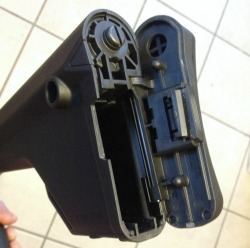 When you pick the rifle up, the first thing you notice is that the rifle feels a lot lighter than you think it will be. I’ll be honest; this was my first experience with the AR-10 platform and I was thinking the rifle would be weighted along the lines of an M1A, for some reason. It was pleasantly nimble at just under 8 ½ lbs, and the weight distribution is fantastic, making for a very lively rifle that’s quick to the shoulder. The Magpul MOE fixed stock was an interesting choice that I didn’t think I would like, but after handling it, you realize that it’s really a pretty good selection for this rifle. I was informed they chose this stock to make it more accessible in places where collapsible stocks are a no-no. As a nice bonus, the Magpul stock opens at the rear, enabling access to a really quite impressive storage compartment for whatever gear you’d like to stuff in there.
When you pick the rifle up, the first thing you notice is that the rifle feels a lot lighter than you think it will be. I’ll be honest; this was my first experience with the AR-10 platform and I was thinking the rifle would be weighted along the lines of an M1A, for some reason. It was pleasantly nimble at just under 8 ½ lbs, and the weight distribution is fantastic, making for a very lively rifle that’s quick to the shoulder. The Magpul MOE fixed stock was an interesting choice that I didn’t think I would like, but after handling it, you realize that it’s really a pretty good selection for this rifle. I was informed they chose this stock to make it more accessible in places where collapsible stocks are a no-no. As a nice bonus, the Magpul stock opens at the rear, enabling access to a really quite impressive storage compartment for whatever gear you’d like to stuff in there.
The Hogue over molded pistol grip is comfortable and its soft rubber composition is easy to muckle on to. The Midwest Industries-supplied 15” rail comes with one 2” long keymod-attached rail for accessory mounting (you can easily order more online), with a full-length picatinny rail running the length of the top of the fore end. The black anodized aluminum rail itself is easy to hold on to, even with gloves or if your hands are wet. The 18” barrel is fluted for increased rigidity, weight reduction, and improved barrel cooling, and it’s capped with a standard A2-type “birdcage” flash suppressor. This rifle is really a very well thought out combination that doesn’t need special aftermarket parts to make it useful or sexy – all that work has already been taken care of for you in this package.
Diving Deeper
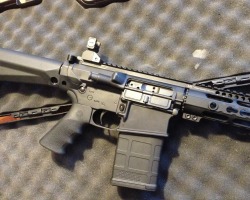 Looking further into the rifle yields some really cool discoveries that make this rifle even better. First off, you’ll notice that either side of the rear of the lower receiver has a small hole, about ½” or so in diameter and ½” deep. These are integrated sockets for push-button quick-detachable sling swivels. As a bonus, the Midwest Industries rail has the sockets copycatted in as well, in the front and rear of the rail, at the 3, 6, and 9 o’clock positions, making for a total of 8 sling mounting positions. The Magpul stock also offers receptacles for their QD sling mounting systems as well as a slot for a sling attachment, bringing the grand total of attachment points to thirteen. No need to buy aftermarket custom loops or mounts; this rifle has them all built-in and will accommodate single-point, or double-point slings. The rifle comes with a black nylon sling, but I mounted a Viking Tactics VTAC sling into the supplied swivels, and it was a dynamite combination.
Looking further into the rifle yields some really cool discoveries that make this rifle even better. First off, you’ll notice that either side of the rear of the lower receiver has a small hole, about ½” or so in diameter and ½” deep. These are integrated sockets for push-button quick-detachable sling swivels. As a bonus, the Midwest Industries rail has the sockets copycatted in as well, in the front and rear of the rail, at the 3, 6, and 9 o’clock positions, making for a total of 8 sling mounting positions. The Magpul stock also offers receptacles for their QD sling mounting systems as well as a slot for a sling attachment, bringing the grand total of attachment points to thirteen. No need to buy aftermarket custom loops or mounts; this rifle has them all built-in and will accommodate single-point, or double-point slings. The rifle comes with a black nylon sling, but I mounted a Viking Tactics VTAC sling into the supplied swivels, and it was a dynamite combination.
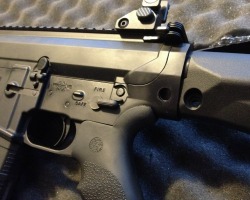 Windham Weaponry took great pains to make sure that their .308 platform AR-15s could fit into the aftermarket world as well. While the supplied trigger is a mil-spec trigger, I was told that AR-15 fire control group parts (trigger, disconnector, hammer, pins, and associated springs) are used and any standard aftermarket AR-15 parts will work in the .308 rifles from WW. So if you wanted to upgrade the trigger with one from Geissele or JP Enterprises, say, it will drop in. While the bolt and carrier are specially designed specifically for the WW .308 ARs, the gas key, gas key screws, and firing pin retaining spring are all common AR-15 parts. A word of caution, though: the Windham Weaponry .308 platform was designed from the ground up with their in-house team of engineers, and as such, some parts will not interchange with other makes of .308 AR. This is a consideration to take into account if you like to have a few spare parts kicking around, just in case.
Windham Weaponry took great pains to make sure that their .308 platform AR-15s could fit into the aftermarket world as well. While the supplied trigger is a mil-spec trigger, I was told that AR-15 fire control group parts (trigger, disconnector, hammer, pins, and associated springs) are used and any standard aftermarket AR-15 parts will work in the .308 rifles from WW. So if you wanted to upgrade the trigger with one from Geissele or JP Enterprises, say, it will drop in. While the bolt and carrier are specially designed specifically for the WW .308 ARs, the gas key, gas key screws, and firing pin retaining spring are all common AR-15 parts. A word of caution, though: the Windham Weaponry .308 platform was designed from the ground up with their in-house team of engineers, and as such, some parts will not interchange with other makes of .308 AR. This is a consideration to take into account if you like to have a few spare parts kicking around, just in case.
Related:AR-15: The Ultimate Gun for Survival
The 18″ barrel is a nice intermediate length, bridging the gap between the 16″ SOCOM offerings, 20″ full-sized AR-10 barrel, and 22″ M1A barrel. The barrel length gives a slight ballistic boost over the shorter barrel, yet is handier to maneuver in tight spaces or thick woods than the longer tubes. It also cuts down on weight substantially over the longer offerings, and is arguably potentially more accurate due to enhanced rigidity. For a “do-it-all” type rifle in a caliber that is as efficient as the .308/7.62×51 is, it’s a good compromise. And, yes, before you ask: it can fire both the .308 Winchester and the NATO 7.62x51mm cartridges.
Range Time
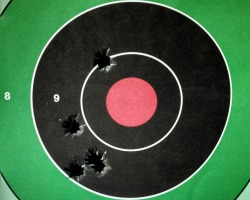 So how does it shoot? I was terrifically excited to get this rifle to the range because, as previously stated, I’d never pulled the trigger on an AR-10 rifle before. I’ve owned, shot, and built AR-15s for a long time, but the .308 AR was new to me. All the controls are the same as a standard AR-15, namely a thumb-actuated safety on the left side of the gun, as is the paddle-type bolt release lever. The magazine release is forward and above the trigger on the right side of the gun, along with the ejection port (with dust cover) and forward assist. All the controls are very accessible and easy to get to – a lesson in ergonomics that shows one of the reasons why the AR-15 platform is so popular. This all contributed to a feeling of comfort bringing the rifle to the range, and there was minimal adjustment time getting familiar. Since I don’t like optics on my rifles unless I’m long-range hunting, I opted to keep the very nice Windham Weaponry sourced flip-up units as the sighting method.
So how does it shoot? I was terrifically excited to get this rifle to the range because, as previously stated, I’d never pulled the trigger on an AR-10 rifle before. I’ve owned, shot, and built AR-15s for a long time, but the .308 AR was new to me. All the controls are the same as a standard AR-15, namely a thumb-actuated safety on the left side of the gun, as is the paddle-type bolt release lever. The magazine release is forward and above the trigger on the right side of the gun, along with the ejection port (with dust cover) and forward assist. All the controls are very accessible and easy to get to – a lesson in ergonomics that shows one of the reasons why the AR-15 platform is so popular. This all contributed to a feeling of comfort bringing the rifle to the range, and there was minimal adjustment time getting familiar. Since I don’t like optics on my rifles unless I’m long-range hunting, I opted to keep the very nice Windham Weaponry sourced flip-up units as the sighting method.
The R18FSFSM-308 sports a 1:10 rifling twist, which means that it is generally geared towards bullets in the 165/168-grain and heavier range. Just to see what would work best for the State of Maine hunting distances – namely 100 yards or less – I grabbed a box each of Remington 150-grain soft points, Federal 165-grain soft points, and Federal 180-grain soft point loadings. I hadn’t had time to start working up handloads yet, so I had to make do with factory fodder. However, it didn’t disappoint: Even with open sights, the rifle shot the 180-grain loads into 2 1/2″ groups at 100 yards from a sitting position with really not much effort. The lighter bullets didn’t fare as well, but were still definitely minute-of-whitetail with groupings in the 3-4″ range. I selected the 180-grain load as the deerslayer of choice. Recoil is not bad at all, as some might wonder. The difference between the lighter 150-grain loads and the 180s was noticeable, especially when shooting prone, but it was not uncomfortable in the least.
This rifle comes with a standard mil-spec trigger, which basically means it’s not exactly match grade. It ran about 5 pounds, maybe a tad more, with the expected creep. However, it was not gritty and the function was smooth and reliable – what you’d want for a battle rifle. If I was going to use the rifle more as a long-range rifle, I’d consider dressing the trigger up some or buying an aftermarket unit. The stock trigger, however, is acceptable for what most people would use it for. The more I used it and dry-fired the gun, the more I became acclimated.
After hunting season (where I bagged a nice little 5-point whitetail buck with the rifle – again, a future article), I had a chance to pop a Burris XTR II 2x-10x scope (wonderful scope, by the way) with a P.E.P.R. Mount onto the rifle with a few starting handloads, shot prone at 100 yards. Right away, the rifle again showed a propensity towards the heavier bullets, with a load of IMR-4985 under a Sierra Gameking 180-grain SP grouping 4 shots under an inch, with a 5th shot a called flyer due to jumping the trigger. Of those 4 shots, three of them are clustered into less than 1/2”. Another load with the same bullet and a charge of IMR-4064 netted similar groups. The 165-grain Nolser Ballistic tip loads I tried shot well for a stock AR, with groups in the 2” range, but they didn’t like cycling in the gun – I’m guessing the plastic tip of the bullets had too much friction against the front of the 5-round magazine I was using(I did load them as long as I could and still fit in the magazine.) This was only with these specific bullets in the 5-round steel magazines, though; full metal jacketed rounds and lead-tipped soft point bullets feed flawlessly. I have yet to try the polymer tipped bullets in the supplied Magpul magazine, but I suspect it will probably alleviate the problem.
A later range session in the dead of winter (10 below with25-35mph winds) showed the rifle’s practical accuracy: how the gun shoots when the conditions aren’t 100% perfect. My fingers were frozen and almost useless, the rest was improvised, my glasses were fogging and snot was running out of my nose as I tried to line up targets. 2-3 inch 5-shot groups at 100 yards were the norm, with one standout handload combination of Varget and a 168-grain Barnes Triple Shock “X” bullet putting 5 rounds into 0.902” center-to-center once the wind died down enough to make accuracy work feasible.
 But, if you consider that this rifle is, without too much trouble, a 2 MOA (minute of angle – 1” at 100 yards is 1 MOA) performer – and I KNOW it can do better if you feel like searching for the right load – that means at 200 yards it theoretically be shooting 4” groups, and at 300 yards, 6” groups. That tells me that with an off-the-shelf load like the Federal 180-grain factory ammo I hunted with, I could comfortably feel safe hitting a target the size of a paper plate at 350-400 yards, no problem, once wind and bullet drop were accounted for. With a dialed-in load like my Varget/Barnes combo, a vitals hit on a deer-sized critter is conceivable out to 500 yards, once the rifle and trajectory are doped in, and I had a solid rest and lots of trigger time with the gun. That’s VERY respectable. As an added bonus, despite the dismal temps and and frozen nose excretions, the rifle functioned 100% with a variety of ammo during my range sessions.
But, if you consider that this rifle is, without too much trouble, a 2 MOA (minute of angle – 1” at 100 yards is 1 MOA) performer – and I KNOW it can do better if you feel like searching for the right load – that means at 200 yards it theoretically be shooting 4” groups, and at 300 yards, 6” groups. That tells me that with an off-the-shelf load like the Federal 180-grain factory ammo I hunted with, I could comfortably feel safe hitting a target the size of a paper plate at 350-400 yards, no problem, once wind and bullet drop were accounted for. With a dialed-in load like my Varget/Barnes combo, a vitals hit on a deer-sized critter is conceivable out to 500 yards, once the rifle and trajectory are doped in, and I had a solid rest and lots of trigger time with the gun. That’s VERY respectable. As an added bonus, despite the dismal temps and and frozen nose excretions, the rifle functioned 100% with a variety of ammo during my range sessions.
Related:The AR-15 Bolt Carrier Group
Pros
-Needs nothing after the addition of sights or optics. One squared-away gun.
-Attractive price-point: Produced in high volume by people who care about their product, for less than the cost of an average mid-to-high end AR-15 build.
-The .308 Winchester caliber can do almost everything you need it to do at distances further than most of us have the capability to be shooting.
-Magpul makes magazines for it. ‘Nuff said.
-Very portable. It was a pleasure to carry slung over my shoulder in the woods (even when dragging out a deer), and it totes nicely in vehicles.
-Comfortable to shoot, accurate for an out-of-the-box AR rifle.
-Accepts lots of aftermarket AR-15 goodies and parts.
-Comes with a hard case, QD sling swivels that mount to sockets that are built right into the gun, a sling and a Magpul 20-round mag.
Cons
-Not a bad trigger, but not the best either. It can be cleaned up or easily replaced with standard AR-15 parts.
-The parts that aren’t standard AR-10 (like the bolt) are proprietary Windham Weaponry pieces.
-LOUD. Sweet holy Jesus loud. I pulled the trigger on a deer last season, and my ears rang for days. If you hunt with this, some sort of electronic ear protection might be a good idea.
-The fixed stock was a little long when I was wearing lots of layers and a wool jacket. For the record, this exact same rifle with a collapsible stock is the R18FSFST-308.
-An ambidextrous safety lever would have been nice, but that’s something that can easily be obtained and swapped out.
Conclusion
After about 500 rounds with the rifle, what do I think? Overall, I REALLY like this rifle. It’s a perfect transition gun for the person who wants more horsepower, but has trained on a .223 AR-15. I think that the scope I had on it, at 2x-10x with a 34mm tube, is a bit much for this smaller rifle; the scope would be much better suited to an M40 or full-sized M14. This rifle with a more compact low-powered scope, say something like the Weaver 1x-5x Tactical, or an ACOG, would put this rifle ready for use at everything from house-clearing distances to something over 250 yards. It’s a well-set-up platform, able to tackle the majority of missions 99% of us would put in front of it. Plus, it’s just bad-ASS. A mean-looking black rifle in a powerful caliber. Some of us just need that too.






